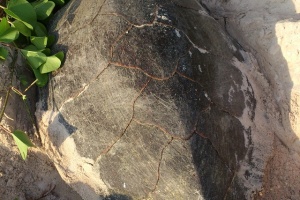Long journey: Hawksbill turtle swims to Seychelles from Australian island
Conservation |Author: Sharon Meriton Jean and Betymie Bonnelame | March 11, 2017, Saturday @ 11:05| 10551 views
A hawksbill turtle swam all the way to the Seychelles to lay her eggs on Frégate Island.(Janske van de Crommenacker, Fregate conservation's )
(Seychelles News Agency) - A hawksbill turtle tagged as a juvenile in the waters of Cocos Keeling Island, an Australian territory, swam all the way to the Seychelles to lay her eggs on Frégate Island.
The conservation manager of Frégate, Janske van de Crommenacker, told SNA that her daily patrol on Grand Anse beach turned into an extraordinary one when she spotted the turtle laying her eggs last month.
“She was tagged with a numbered metal tag, but instead of Seychelles, I noticed that the tag had written Canberra, Australia on it,” she says.
The news of the sighting was also thrilling for Seychellois turtle expert Jeanne Mortimer, who revealed that this is a first for Seychelles, an archipelago in the western Indian Ocean.
“There has been sightings of turtles tagged in Seychelles in Kenya or vice versa but never a turtle from Australia,” said Mortimer.
 |
| The turtle was tagged with a numbered metal tag, but instead of Seychelles, the tag had written Canberra, Australia on it.(Janske van de Crommenacker, Fregate conservation's ) Photo License: CC-BY |
Excited by Janske’s discovery, the Frégate team is keen on seeing the female turtle again in the hope of attaching a satellite tag to it.
Although titanium tags attached to the flippers of sea turtles help to monitor them from around the world, a satellite tag, similar to those being used recently on green turtles of Aldabra Atoll, a refuge for these species in Seychelles, could help to monitor this particular long-distance-travelling turtle.
“This type of tag communicates through a little antenna with a specialised satellite and every day you can see via the internet where the turtle is and follow its movements,” says Janske.
Hawksbill females lay their eggs every two weeks for up to six or seven times during a season, but for some unknown reason; this turtle has yet to emerge again.
Hawksbills turtles, named because of their narrow pointed beaks, are found mainly throughout the world’s tropical oceans, predominantly coral reefs. They are listed as critically endangered on the red list of the International Union for Conservation of Nature (IUCN). They are a considered as a fundamental link in marine ecosystems and help maintain the health of coral reefs and sea grass beds.
It is believed that sea turtles nest on the same beach where they were born and Mortimer said that this turtle could have travel the 4,600 kilometers to Australia to forage when she was tagged in 2005.
The satellite tag, said Mortimer, could help determine if as an adult she prefers to feed in the Seychelles Bank, like most adult female hawksbills nesting in the western Indian Ocean Islands or she prefers her old forage ground in Cocos Keeling.
 |
| A total of 834 emergences and at least 330 nests have been counted in the current nesting season that started in September 2016. (Janske van de Crommenacker, Fregate conservation's ) Photo License: CC-BY |
Located some 55 kilometres from the main island of Mahe, Frégate’s pristine beaches are frequented more by sea turtles than human visitors every year.
A year-round monitoring programme on the island helps to keep statistics on the species, which also nests on other beaches such as Anse Victorin, Anse Maquereau and Anse Bambous.
According to the Frégate’s conservation team, a total of 834 emergences and at least 330 nests have been counted in the current nesting season that started in September 2016.
Given that a hawksbill turtle nest contains on average about 150 eggs, this would mean that nearly 50,000 baby turtles have been born on Frégate only in the last few months.
Back
